Name an aquarium fish, and I guarantee you 9/10 times a pleco is recommended as a tank mate.
Why?
Because they’re simply an awesome fish to have in your tank. Chilling at the bottom, hoovering up messes, and eating up unwanted algae (most of the time, it depends, we’ll get to it).
But which type is right for you? Because there are some you need to know about. Choose the wrong pleco and you could end up with a two foot monster in your tank
But don’t fear, Kate is here.
There are more than 150 different species of Pleco that have been discovered, and almost all of them shouldn’t be kept in an aquarium.
Here are 10 types of plecos you should be aware of and what type of aquarium they require.
1. Common Pleco (Pterygoplichthys pardalis)
- Size: 18-24 inches (46-61 centimeters)
- Min. tank size: 100 gallons (379 liters)
- Care level: medium
- Diet: herbivore
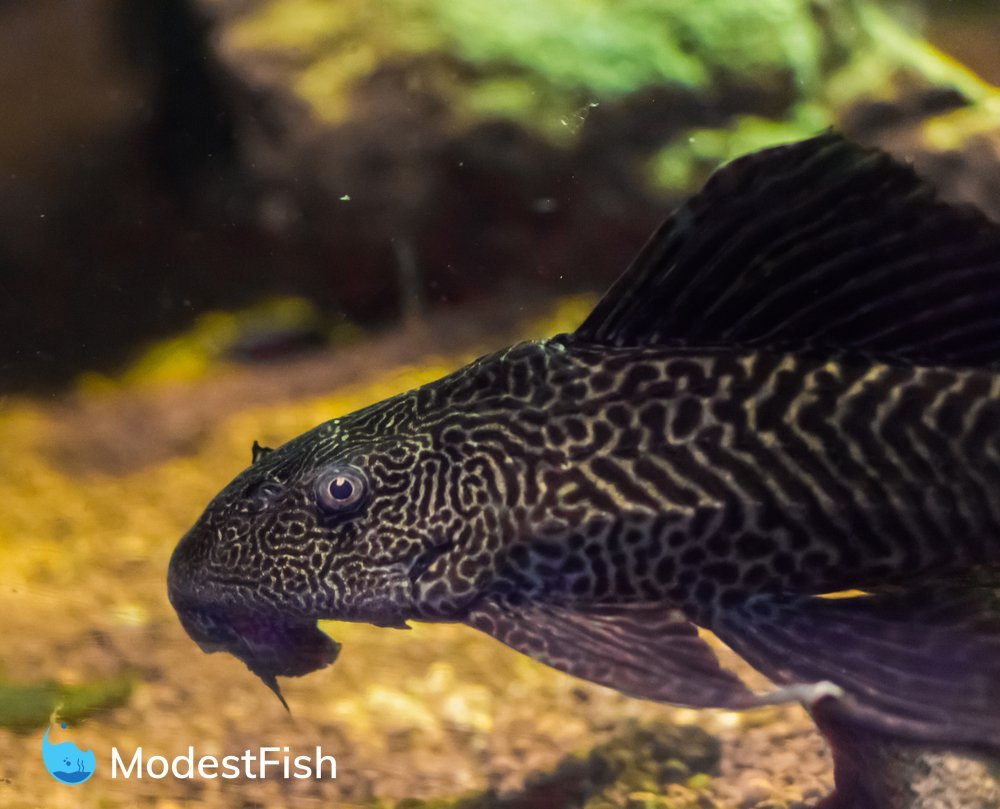
This is the species of pleco that you will find most often in the aquarium trade, which is a travesty, in my opinion. It’s not that I don’t like this fish, they’re a good algae eater and I think they’re really neat looking.
But they get HUGE and most people don’t realize this when they buy them!! I’ve seen people try to keep them in a 10 gallon tank, a fish that grows to 18 inches, in a 10 gallon! They need to be in a tank 10 times that size, at least.
I think it’s really irresponsible for live fish stores to sell this species when the vast majority of aquarists cannot house them properly. I have four tanks and am a total fish geek and I can’t house this fish. So please, only buy one of these if you already have a 100 gallon tank. This fish is very fast growing, it will usually grow to be at least 12 inches (30 centimeters) within a year, so you can’t count on upgrading to a bigger tank later.
Pro Tip: Please, do careful research on fish species before you buy them. Make sure that you can take care of a fish long term before you bring them home.
2. Bristlenose Pleco (Ancistrus sp.)
- Size: 4-6 inches (10-15 centimeters)
- Min. tank size: 40 gallon (151 liters)
- Care level: easy
- Diet: herbivore
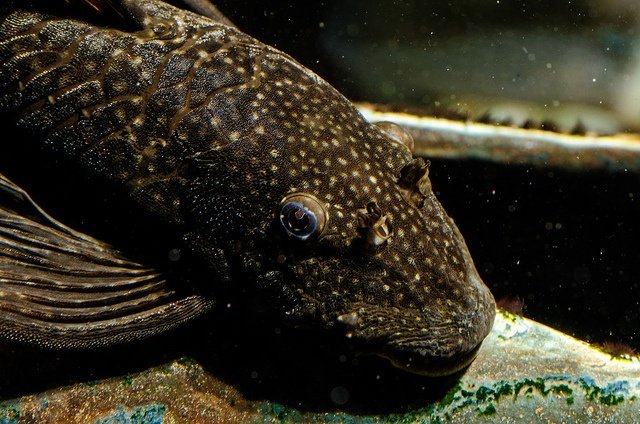
I often get asked which pleco I recommend. I almost always end up naming the bristlenose. They are great little algae eaters, come in a variety of color morphs and males are interesting little oddballs that make the tank more interesting.
That’s because they grow a mass of fleshy tentacles on their faces that they use for ritualized combat with other males. Females may sport a few tentacles, but nothing like the crazy beard that males develop. These fish stay relatively small but can still keep a 55 gallon tank free of surface algae, in my experience.
3. Clown Pleco (Panaqolus sp.)
- Size: 3.5-4inches (9-10 centimeters)
- Min. tank size: 30 gallons (113 liters)
- Care level: easy
- Diet: herbivore
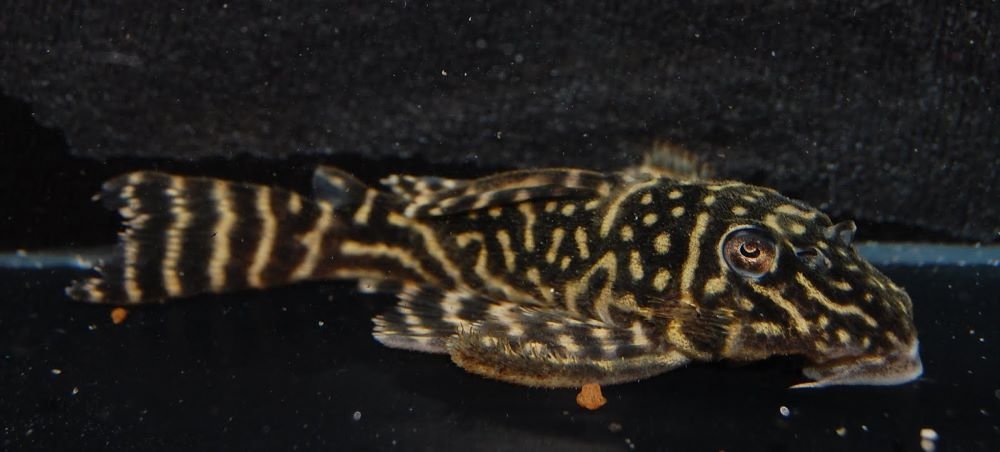
This little fish is another one of my favorites. I’ve had one in my rainbowfish tank for years. They do eat some algae, but they’re not the most efficient clean up crew in my experience. In nature, they eat primarily wood fiber from sunken logs.
They are small fish and will not grow into giant tank busters at all. Their coloring is really neat. The base color is a light brown cut through by stripes of mustard yellow.
4. Rubber Lip Pleco (Parancistrus aurantiacus)
- Size: 7 inches (18 centimeters)
- Min. tank size: 55 gallons (208 liters)
- Care level: medium
- Diet: omnivore
The rubber lip pleco looks very similar to the common pleco, but it isn’t nearly as huge. I also think that it’s a really cool looking fish. There is a lot of definition around each of their body scales, making their armored scales even more distinct. They will eat some algae, but should also be supplemented with some meaty foods.
5. Butterfly Pleco (Dekeyseria picta)
- Size: 5.5 inches (14 centimeters)
- Min. tank size: 40 gallons (151 liters)
- Care level: easy
- Diet: herbivore
The butterfly pleco is a striking little fish with big showy fins. It is also one of the more interesting plecos since it can dramatically change its coloration, almost like a chameleon. It will turn itself almost completely black in order to blend in with a dark substrate.
Against a light colored substrate, it will have a beautiful pattern of black and white stripes, similar to a zebra pleco. This species will eat algae and benefits greatly from having driftwood in the tank.
6. Galaxy Pleco (Leporacanthicus galaxias)
- Size: 8 inches (20 centimeters)
- Min. tank size: 75 gallons (284 liters)
- Care level: medium
- Diet: carnivore
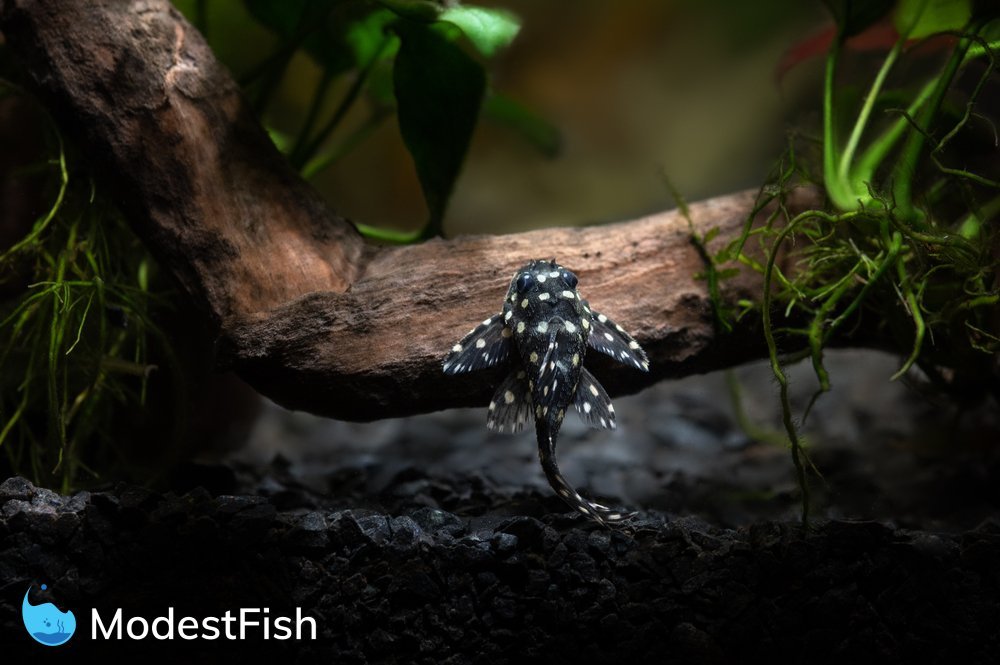
Also known as the vampire pleco, this species is carnivorous and does not eat algae. They especially like meaty foods like shrimp and snails. This is a truly beautiful species that is a dark brown or black and is covered in close-packed yellow spots that look like the stars at night.
7. Zebra Pleco (Hypancistrus zebra)
- Size: 3 inches (7.5 centimeters)
- Min. tank size: 20 gallons (76 liters)
- Care level: medium
- Diet: carnivore
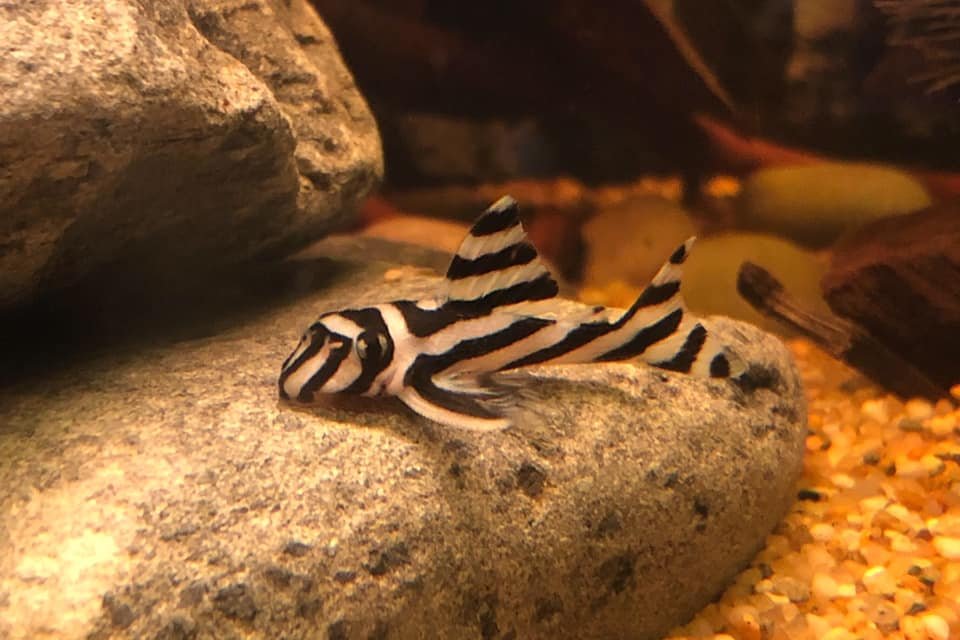
This little guy is considered the gem of the pleco world. It’s pretty obvious where they get their name when you see one. They’re white with distinct black stripes that look almost too perfect to come from nature.
But, this little beauty does not eat algae, not even a little bit. You don’t keep this fish because it helps with algae, you keep it purely for aesthetics. They will need to be fed lots of meaty foods, like shrimp, bloodworms and/or brine shrimp. They can adapt to a wide variety of water conditions but they need a high flow rate in their tanks and well oxygenated water.
8. Gold Nugget Pleco (Baryancistrus xanthellus)
- Size: 9.5 inches (24 centimeters)
- Min. tank size: 75 gallons (284 liters)
- Care level: medium
- Diet: omnivore
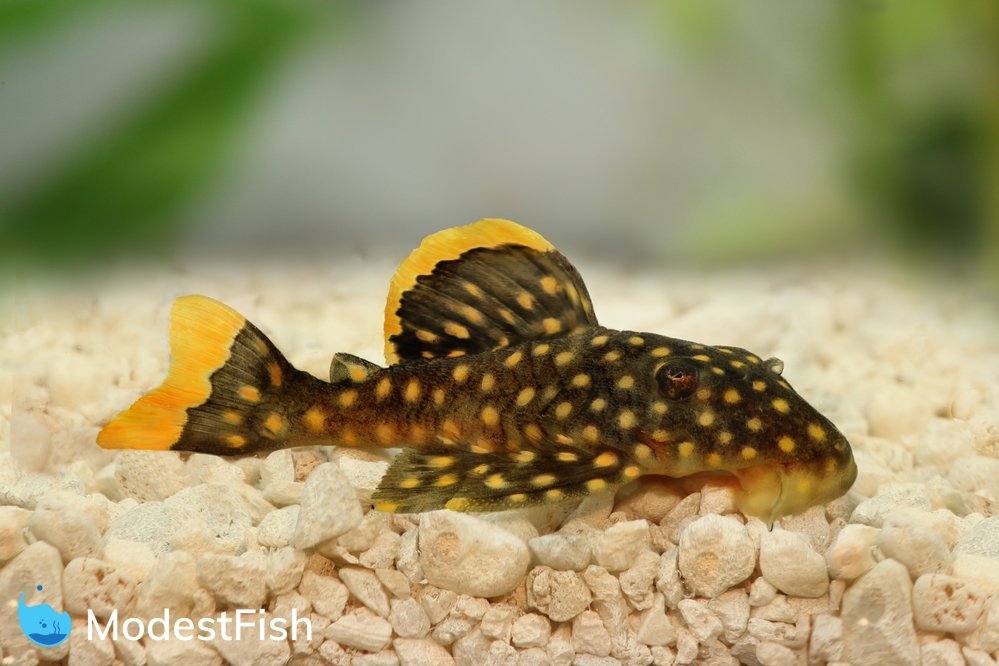
The gold nugget is another stunning pleco that’s kept more for it’s gorgeous looks than it’s algae eating abilities. They are a rich dark brown color, with perfectly round yellow dots covering their bodies and large stripes of the same yellow along the trailing edges of their dorsal fins and tails.
This species will need to be offered a mix of meaty foods along with plant matter. They generally don’t eat algae in an aquarium environment. Just like zebra plecos, gold nuggets need heavily oxygenated water with a high flow rate.
9. Royal Pleco (Panaque nigrolineatus)
- Size: 17 inches (43 centimeters)
- Min. tank size: 100 gallons (379 liters)
- Care level: medium
- Diet: herbivore
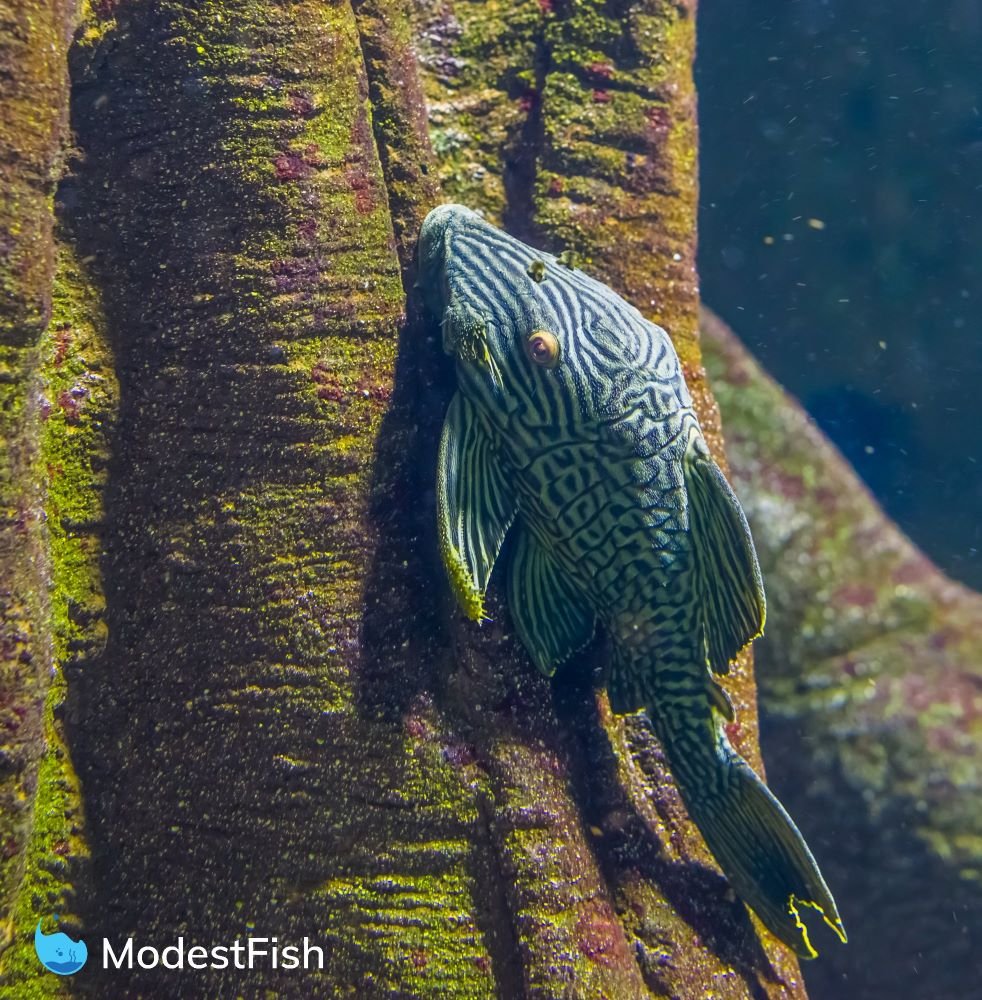
The royal pleco is another species that can grow into a tank buster. But, if you’ve got the room, I think they’re so much more interesting to look at than a common pleco. Their base color is a light brown and they have dark brown stripes running from nose to tail.
This color pattern looks very similar to wood grain which is handy camouflage that helps them blend in while they feed on sunken logs. They also have bright red eyes that really stand out. Royal plecos are herbivores that will eat algae in the aquarium, but their large size makes them impractical for many fish keepers.
10. Sunshine Pleco (Scobinancistrus aureatus)
- Size: 12 inches (30 centimeters)
- Min. tank size: 100 gallons (379 liters)
- Care level: medium
- Diet: omnivore
This species is aptly named. Their base color is a dark olive green to brown and they are absolutely covered in bright orange spots. Sunshine plecos don’t become as huge as commons, but at a foot long, they’re still quite substantial. This species is kept more for their brilliant coloration than their ability to eat algae.
Do plecos eat algae?
Yes… maybe… but maybe not.
OK so some species of plecos live almost exclusively on algae and wood fiber.
But…
There are many species that eat a carnivorous diet and want nothing to do with algae.
So, if you want a pleco purely for algae eating, be very careful which species you choose.
A pleco might look pretty in the tank, but it might not do anything to beat back algae.
Pleco Behavior
In the wild, most plecos are nocturnal fish that spend the daylight hours hiding under sunken logs or in small caves and crevices.
They emerge at night to feed on algae, driftwood, aquatic plants and/or scavenging dead fish, depending on the species.
They are also very territorial. They will fight off other plecos that come near their feeding grounds and especially their hiding spots.
For this reason, you should not keep more than one pleco in your tank, even if they’re different species. They will usually bully and harass each other until one becomes completely stressed out and dies.
They Can’t Fix a Tank Out of Balance
Plecos are good at eating up a little algae here and there.
But they’re not going to take care of a horrendous algae problem in your tank.
It’s up to you as an aquarist to do this.
So don’t pin all your hopes on a fish fixing everything for you.
Pro Tip: For tips on dealing with pesky aquarium algae, see our article on algae types
Which Kind Of Pleco Should You Get?
